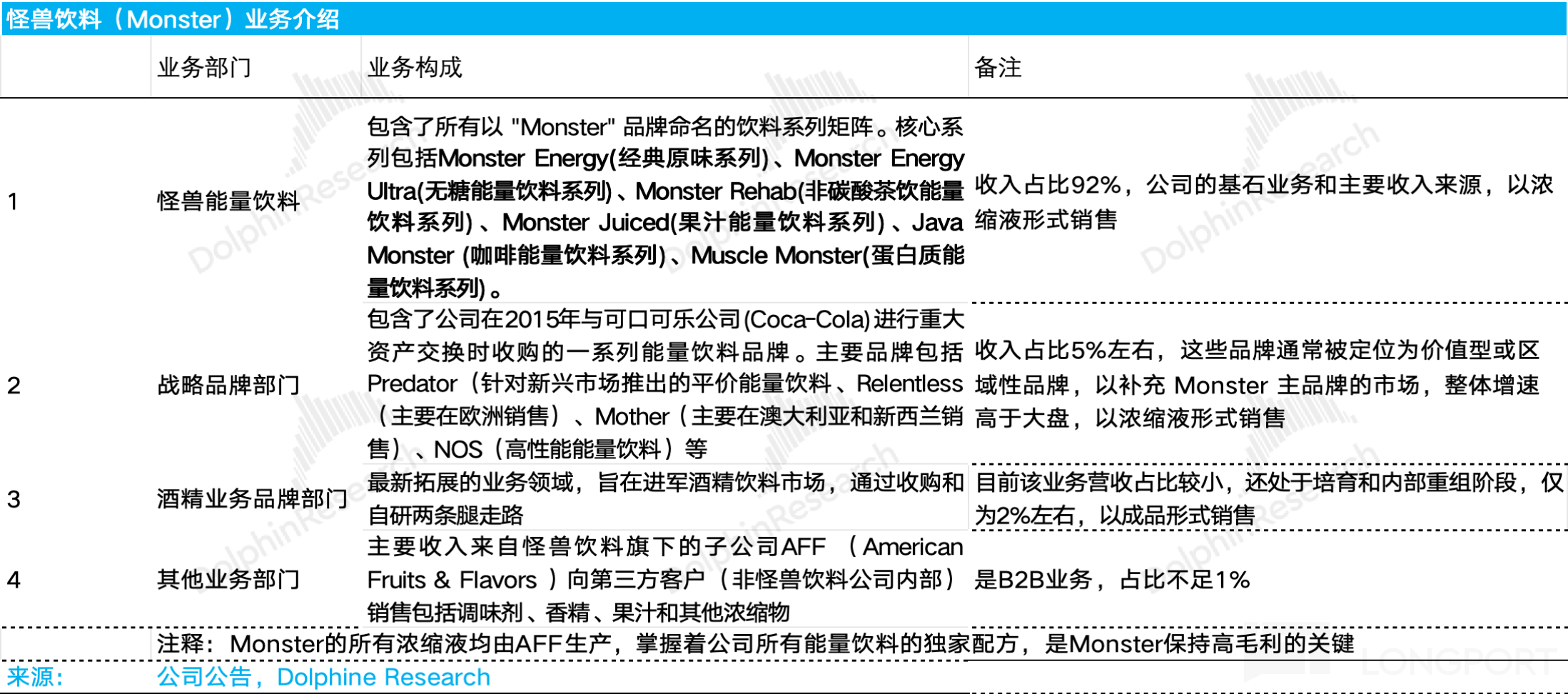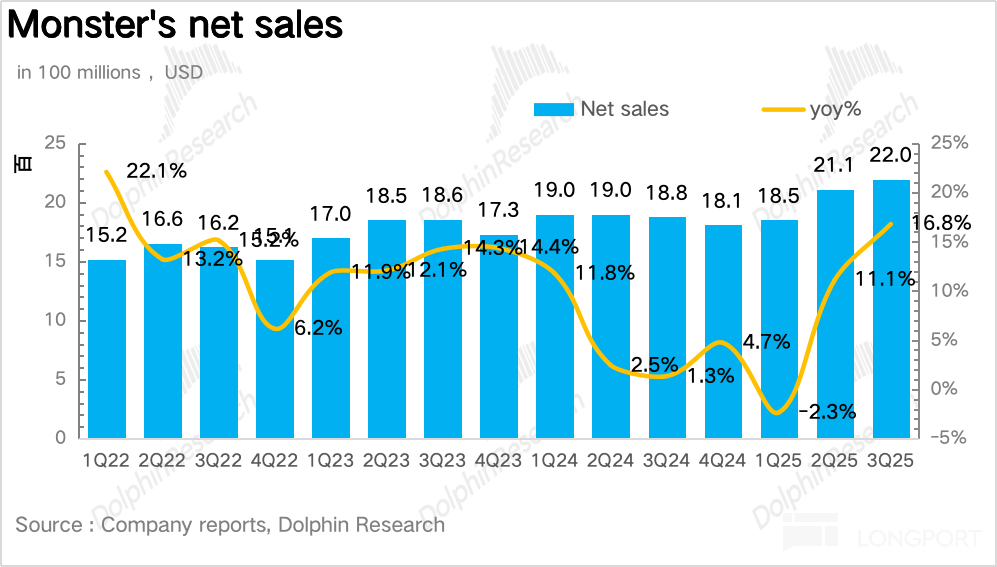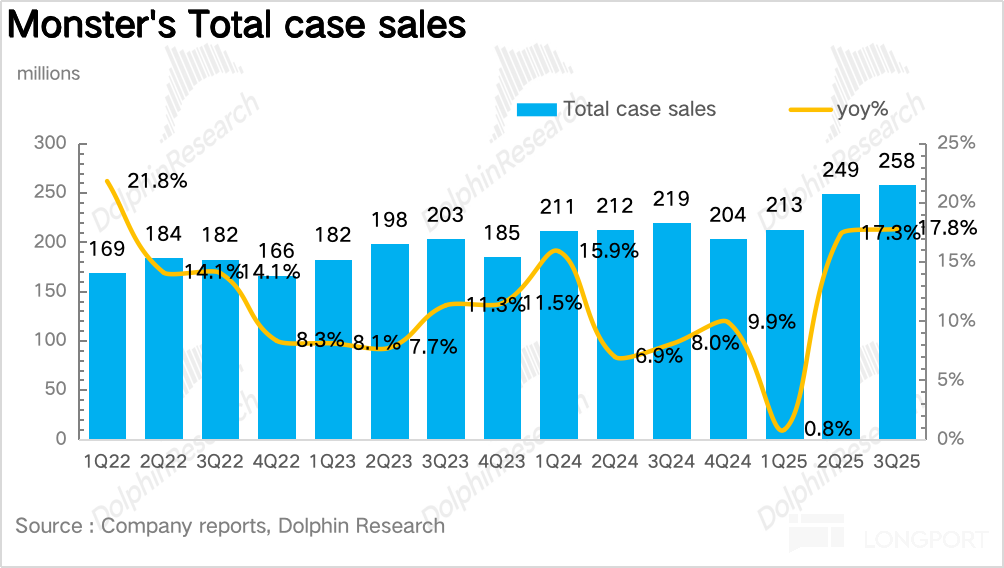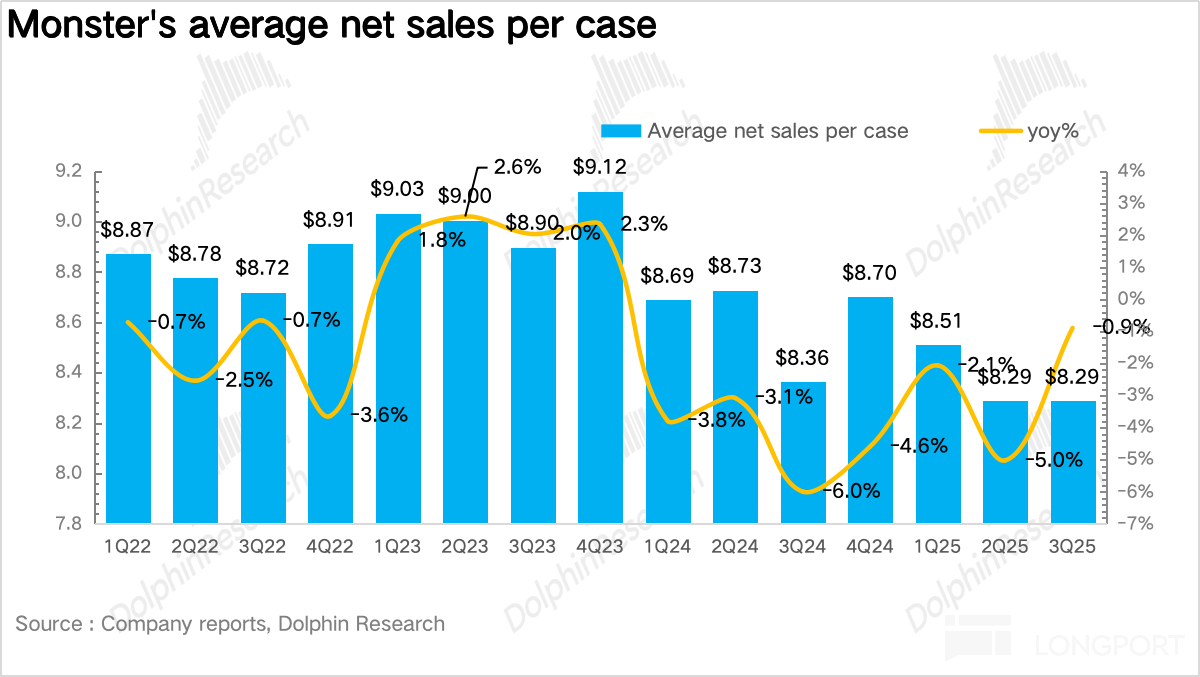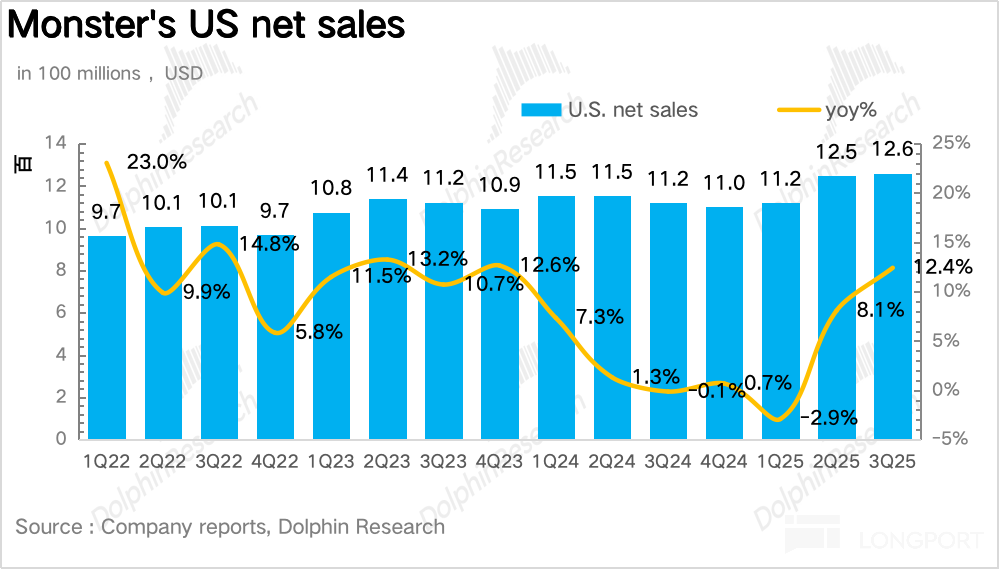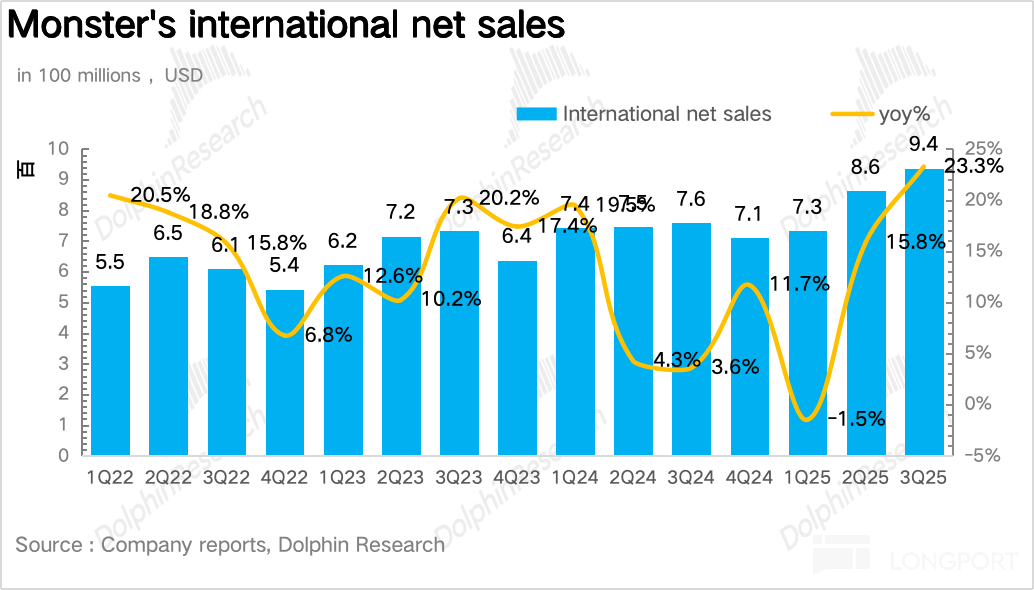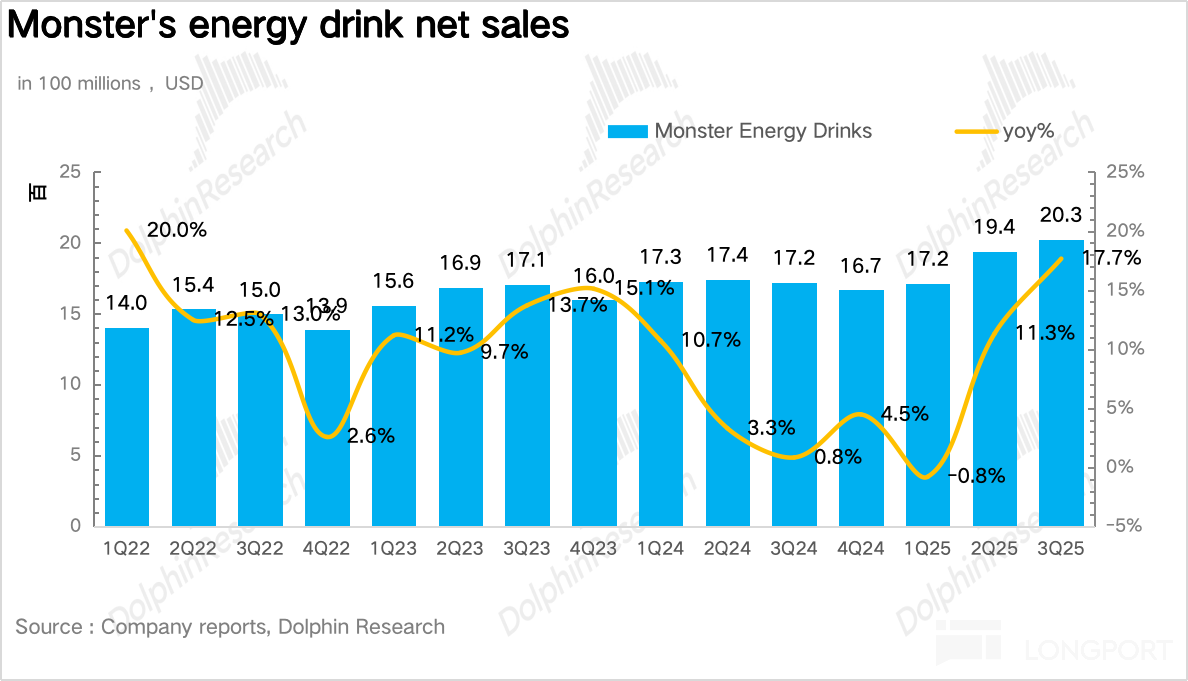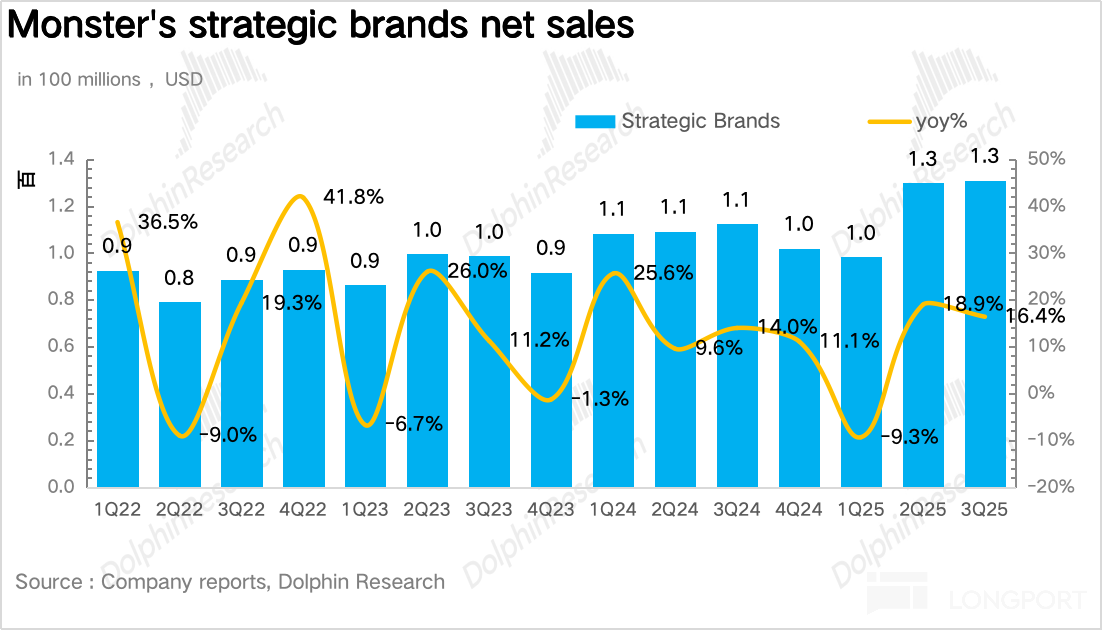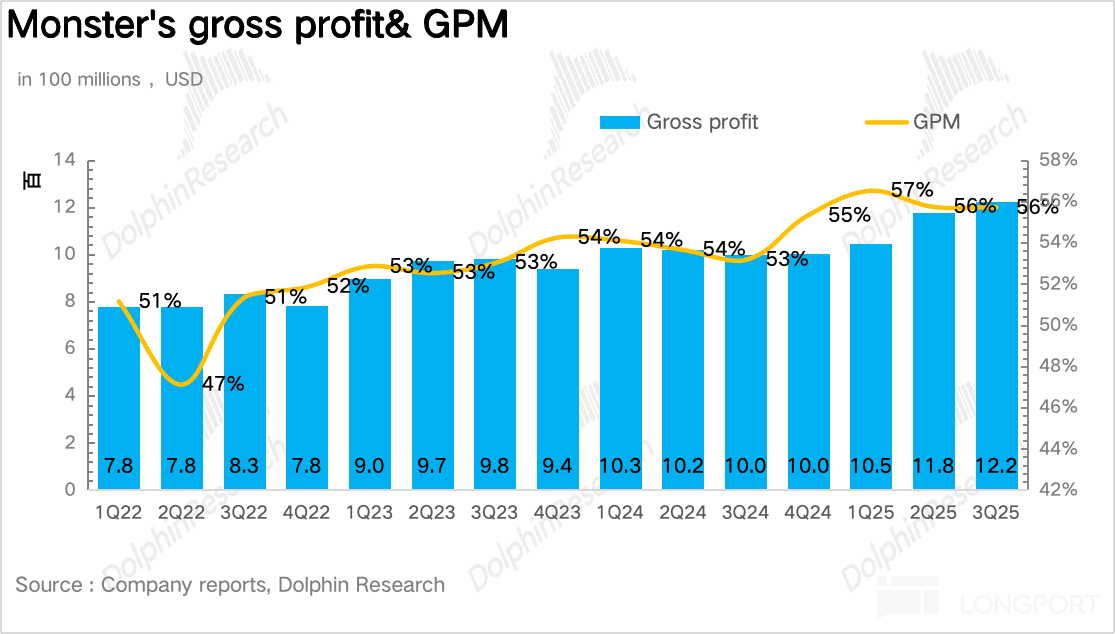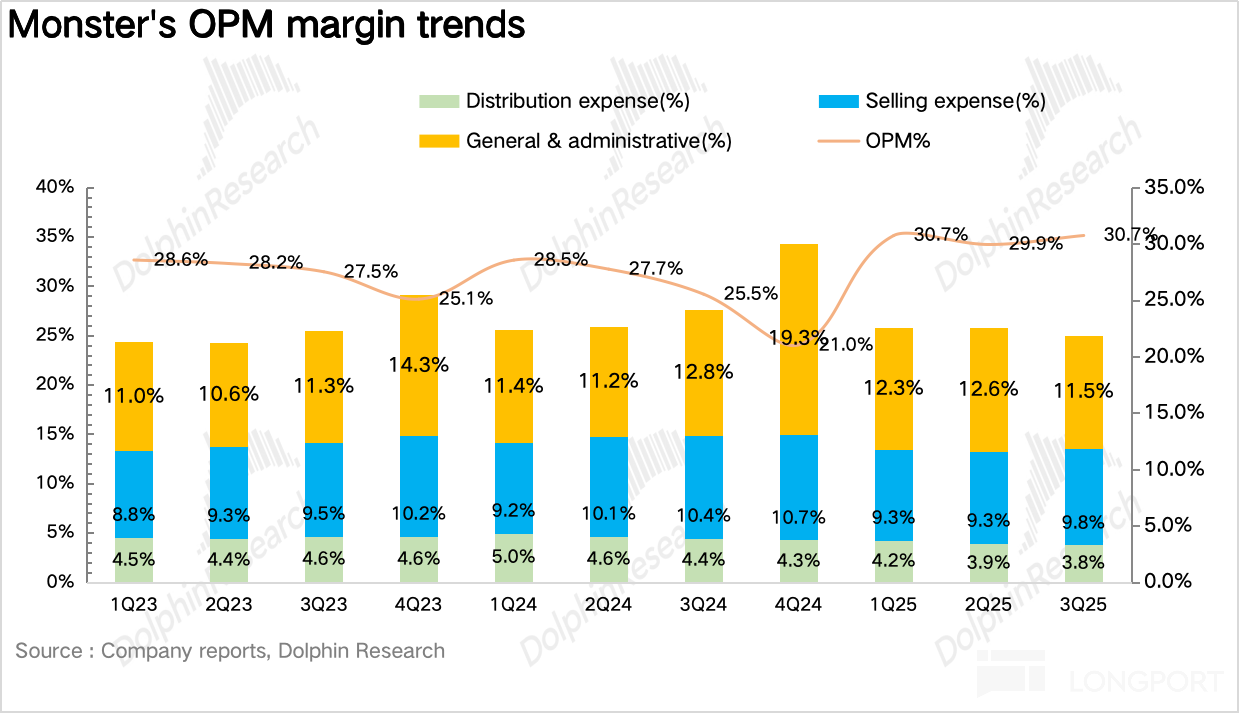
Monster: Evolution of the Beast! Will the Frenzy Begin Again?

$Monster Beverage(MNST.US) The leading energy drink company, Monster Beverage (MNST), released its third-quarter 2025 financial report (ending September 2025) after the U.S. stock market closed on the morning of November 7, 2025, Beijing time.
- Revenue growth rate hit a single-quarter high in three years. In 3Q25, Monster achieved revenue of $2.2 billion, a year-on-year increase of 16.8%, exceeding market expectations. In terms of volume and price breakdown, Monster's unit case sales increased by 17.8% year-on-year, continuing the high growth trend from the second quarter. The core reason is the company's active strategy adjustment since the beginning of the year, increasing operations and new product launches in the health category, attracting a large number of health-conscious incremental consumers. The price side decreased by 0.2% year-on-year, with the decline narrowing compared to the previous two quarters, mainly due to the increased proportion of high-priced products like Ultra (zero sugar) in the company's product mix.
- International market share continues to rise. Regionally, the U.S. domestic market achieved revenue of $1.26 billion, a year-on-year increase of 12.4%, returning to double-digit growth. The international market achieved revenue of $730 million, a year-on-year increase of 23.3%, further increasing its share to 42.6%, mainly due to Monster's increased promotion of affordable energy drinks like Fury and Predator in regions with weakened purchasing power. Overall, both the domestic and international markets showed accelerated growth compared to the previous quarter.
3. Monster Beverage's main brand leads the market. In terms of brand breakdown, Monster Beverage's main brand grew by 17.7% year-on-year, leading the market growth rate, with the core being the Ultra series, which significantly increased sales through active product innovation, currently accounting for nearly 40%. Other strategic brands grew by 16.4% year-on-year, with a slight decline in growth rate compared to the previous quarter. The alcohol business declined by 17%, still in the adjustment phase.
4. Profitability significantly increased: In terms of gross margin, influenced by the company's price increase in the fourth quarter of last year and the increased proportion of high-priced products, the company's gross margin increased by 2.5 percentage points year-on-year to 55.7%. On the expense side, with the company's refined operations and improved operational efficiency, all expense rates declined, ultimately leading to a significant increase in core operating profit margin by 5.2 percentage points to 30.7%.
5. Financial indicators overview

Dolphin Research's overall view:
Despite foreign banks being able to track the energy drink market and each brand's terminal sales situation based on Nielsen's monthly data, it is clearly observable from the data that whether in terms of purchase rate, purchase frequency, or single consumption amount, Monster was in a state of accelerated growth compared to the previous quarter in the third quarter, and Monster's market share across all channels also rebounded from 29% in the same period last year to around 35%. Therefore, foreign banks generally raised their expectations for the third quarter before the financial report, and from the actual performance of the final report, Monster's performance actually exceeded expectations, making it a very good result. So, what exactly caused Monster to transform from a seemingly faltering "sick cat" back into a "monster"? Dolphin Research shares its thoughts:
Firstly, at the industry level, Dolphin Research's original expectation in Monster: Besieged on All Sides, Will the Former "Monster" Become a "Sick Cat"? was that after more than 20 years of development in North America, the penetration rate among core consumers (males aged 18-35) was approaching a bottleneck, and the subsequent transition to a single-digit growth stage of 7%-8% was expected. However, according to Nielsen's terminal scan data, energy drinks in North America still show very strong vitality, maintaining double-digit high growth, and are basically unique among non-alcoholic beverage categories.
Dolphin Research believes the core reason behind this is that, driven by many emerging brands like Celsius, Alani Nu, and Ghost focusing on health and segmented functional needs, the label of the energy drink category has transformed from the traditional single "stay-up-late refreshing water" to "healthy lifestyle beverage," successfully attracting a large number of new users sensitive to health. In addition, the high-frequency innovation of new products and the creation of topics and freshness through new media also lead other mature categories. Therefore, Monster's impressive performance is naturally inseparable from the renewed vitality of the energy drink category itself.

Additionally, for Monster itself, it can be seen that the company has undergone significant changes in its approach since the first quarter of this year:
On one hand, Monster changed its product launch rhythm from the beginning of the year, compared to competitors who generally tend to "charge" by launching new products on a large scale in the spring, betting on the performance of the summer peak season, Monster evenly distributed the planned new products throughout the four quarters. This not only avoids the "spring new product melee" but also continuously stimulates consumer purchasing desire, preventing brand popularity from declining during the autumn and winter off-season.
Dolphin Research previously mentioned that, unlike domestic energy drinks which are more driven by "functional" needs for refreshing, with a rigid demand attribute, consumers tend to choose the most familiar and trusted products, so the big single product strategy can be effective. In contrast, energy drinks in Europe and America have long surpassed the simple refreshing function attribute, more expressing personality and lifestyle, with a leisure attribute, so frequent new launches and continuous market stimulation are crucial for increasing consumer stickiness.
On the other hand, Monster has significantly increased its operations in the health category, attempting to reverse the unhealthy brand image in consumers' minds. According to information from the company's conference call, Monster began adopting a product-population-channel-operation combination approach for the health category, independently operating for different segmented populations and channels, which can be compared to Coca-Cola's de-averaging strategy.
For example, the Ultra (sugar-free) series, as Monster's most important growth engine in recent years, directly targets the population that rejects traditional energy drinks (health-conscious, fitness-oriented, unwilling to consume excessive sugar), especially female consumers. In terms of channels, Monster specifically added channels related to healthy lifestyles such as gyms and yoga studios for the Ultra series. In marketing, Monster increased sponsorship in the fitness field, mainstream sports events, and lifestyle influencers, cutting ties with the company's early "unrestrained, extreme, wild" brand image.
After a series of combination punches, although it is difficult to completely reverse the brand image in the short term, the results show that Monster's current strategy is effective, successfully attracting incremental consumer groups such as female consumers and fitness enthusiasts who previously rejected traditional energy drinks with "high sugar and high caffeine".
Finally, in terms of valuation, Dolphin Research has also revised its model upwards based on Monster's current impressive performance, currently corresponding to around 31x for 2026, which is a reasonable valuation level compared to Dolphin Research's estimated 20% profit growth rate for 2026-2029. However, if Monster can continue to prove to the market through the current series of combination punches that it can restore the previously declining market share and maintain high growth in the international market, then Monster's valuation still has room for further upward movement.
I. Investment Logic Framework
According to Monster's official disclosure, the company's revenue growth can be broken down into four major departments: Monster Beverage, strategic brands, alcohol business brands, and other businesses, among which:
- Monster Energy Drink Department: The company's cornerstone business and main source of revenue, currently accounting for about 92% of the department's revenue, includes all beverage series matrices named with the "Monster" brand. Core series include Monster Energy (classic original series), Monster Energy Ultra (sugar-free energy drink series), Monster Rehab (non-carbonated tea energy drink series), Monster Juiced (juice energy drink series), Java Monster (coffee energy drink series), Muscle Monster (protein energy drink series).
(2) Strategic Brand Department: This department mainly includes a series of energy drink brands acquired by the company during a major asset exchange with Coca-Cola in 2015. These brands are usually positioned as value or regional brands to complement the Monster main brand market, with major brands including Predator (affordable energy drink launched for emerging markets), Relentless (mainly sold in Europe), Mother (mainly sold in Australia and New Zealand), NOS (high-performance energy drink), etc., currently accounting for about 5% of the strategic brand department's revenue, with growth slightly higher than the market.
(3) Alcohol Business Brand Department: This department is Monster's latest business expansion area, aiming to enter the alcoholic beverage market through acquisition and self-research. Currently, the business revenue share is small, still in the cultivation and internal restructuring stage, accounting for only about 2%.
(4) Other Business Department: This department has the smallest revenue share, mainly from Monster Beverage's subsidiary AFF (American Fruits & Flavors) selling flavorings, fragrances, and other concentrates to third-party customers (outside Monster Beverage Company), which is a B2B business. It should be noted that all Monster concentrates are produced by AFF, holding the company's exclusive formula for all energy drinks, which is key to Monster's high gross margin.

- Revenue hit a single-quarter growth rate high in three years
In 3Q25, Monster achieved revenue of $2.2 billion, a year-on-year increase of 16.8%, exceeding market expectations. From the trend perspective, Monster reversed last year's downward trend in growth rate, accelerating for two consecutive quarters since the second quarter, and has basically returned to the normal growth rate level before 2023.

Volume: In terms of volume and price breakdown, as the core driver of Monster's current performance, in 3Q25, Monster achieved sales of 260 million cases, a year-on-year increase of 17.8%, continuing the high growth trend from the second quarter. Combined with the previous analysis, on one hand, after the company increased its operations in the health category, the "health-oriented" product line represented by Ultra continued to grow rapidly, attracting consumers pursuing zero sugar and health.
On the other hand, for the sales peak season, the company launched a large-scale points redemption event "Summer of Monster Mayhem" in North America, where consumers can earn points by purchasing any Monster product to redeem Monster customized items and high-value prizes, stimulating large-scale consumer purchases.

Price: In 3Q25, Monster's average price reached $8.3, a year-on-year decrease of 0.2%, with the decline narrowing compared to the previous two quarters. Although Monster increased prices by about 4% for most of its product portfolio in the fourth quarter of last year and reduced promotional subsidies, the rapid growth of affordable brands in the international market lowered the company's overall price. Overall, with the increased share of the international market, the company's overall price gradually declining is within expectations.

III. International market share further increased
Regionally, overall, both the domestic and international markets showed accelerated growth compared to the previous quarter. In Monster's domestic market, North America achieved revenue of $1.26 billion, a year-on-year increase of 12.4%, with Nielsen data showing that the Ultra series, driven by two new products Ultra Vice Guava (guava flavor) and Ultra Blue Hawaiian (tropical fruit mix flavor), entered the top three in the entire energy drink market in North America, which is the key driver for Monster's domestic market returning to high growth.
The international market achieved revenue of $730 million, a year-on-year increase of 23.3%, further increasing its share to 42.6%. On one hand, Monster increased the frequency of new product launches in the international market, and on the other hand, in international emerging markets, the company increased the promotion of affordable energy drink brands (such as Predator and Fury) in regions with weakened purchasing power, pursuing market share improvement through price-for-volume.


IV. Monster Beverage's main brand leads the market.
In terms of brand breakdown, Monster Beverage's main brand achieved revenue of $2.03 billion, a year-on-year increase of 17.7%, leading the market growth rate, with its share increasing by 0.7 percentage points to 92.3%. Among them, the Ultra zero sugar series benefited from flavor iteration innovation, attracting a large number of fashion-conscious and fitness-oriented female consumers, as the absolute core growth driver, currently accounting for nearly 40%. The Java (coffee energy drink) and Rehab (non-carbonated tea energy drink) series also belong to the health category, and Dolphin Research speculates that their growth rate is higher than the overall market growth, but due to relatively niche scenarios, their contribution to Monster's overall market is not significant.
Other strategic brands achieved revenue of $130 million, a year-on-year increase of 16.4%, with a slight decline in growth rate compared to the previous quarter. Among them, Predator and Fury, as representative brands of affordable energy drinks, showed strong growth in markets such as India, Africa, and Mexico, and Bang showed good growth in e-commerce channels after formula upgrades and visual updates. The alcohol business declined by 17%, still in the adjustment phase.


V. Profitability significantly increased
In terms of gross margin, on one hand, with the increased proportion of high-priced new products like Ultra, combined with the price increase at the end of last year by Monster, which has been basically transmitted to all channels after more than half a year of digestion, and on the other hand, the decline in aluminum can prices, the overall gross margin increased by 2.5 percentage points year-on-year, reaching 55.7%.
On the expense side, with the company's refined operations and improved operational efficiency, all expense rates declined.
Among them, with Monster's improved distribution efficiency through the Coca-Cola distribution system in the international market, the distribution expense rate decreased by 0.6 percentage points to 3.8%. In terms of marketing investment, the company gradually shifted from traditional extreme sports "wide net" sponsorship to more efficient, data-driven digital marketing and game collaborations, with the sales expense rate decreasing by 0.6 percentage points to 9.8%.
Ultimately, core operating profit reached $680 million, a year-on-year increase of 40%, with core operating profit margin significantly increasing by 5.2 percentage points to 30.7%, exceeding market expectations.


<End of text>
The copyright of this article belongs to the original author/organization.
The views expressed herein are solely those of the author and do not reflect the stance of the platform. The content is intended for investment reference purposes only and shall not be considered as investment advice. Please contact us if you have any questions or suggestions regarding the content services provided by the platform.




